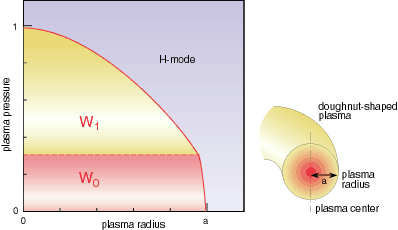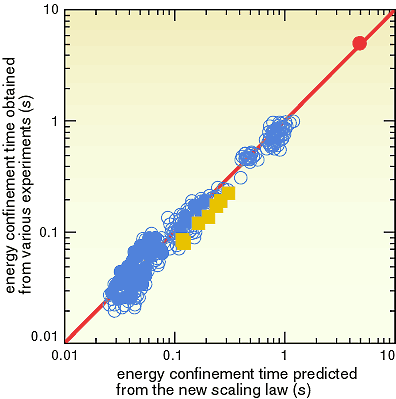The performance of the thermal energy containment of fusion plasmas
is generally evaluated in terms of an "energy confinement time." Unfortunately, no formula for the energy confinement time derived
on a theoretical basis from the physics of fusion plasmas is available
for the evaluation and/or prediction of plasma performance, and
"confinement scaling laws" are widely used instead. A confinement scaling law is an empirical
formula for the energy confinement time obtained from an analysis
of extensive statistical processing of experimental data, being
expressed as a function of major plasma physics and engineering
parameters (magnetic field intensity, magnitude of plasma current
and others), and applicable to a wide range of tokamak confinement
experiments. Many scaling laws have been proposed depending on
current theoretical and experimental progress.
Recently, we have developed a new scaling law for a particular
H-mode confinement that is characterized by the existence of relatively
small scale fluctuations at the plasma periphery, a kind of high
quality confinement considered to be preferable for the steady-state
operation of a tokamak. As shown in Fig. 2-7 this type of confinement
has a characteristic two-part distribution of plasma pressure
showing a steep rise in thermal energy at the plasma periphery
(shown as a trapezoid-shaped W0) and a gentle increase towards the plasma center (a bell-shaped
W1). The energy confinement time is defined as the ratio of the
plasma total energy to the heating input power. We consider that
the total plasma energy is given by the sum of the above-mentioned
two parts, and have made a detailed analysis and processing of
experimental data, on the assumption that the physical processes
in the W0 plasma are governed by the magnetohydrodynamic stability of the
plasma near the boundary, and that the physics in the W1 plasma are dominated by the transport of heat and plasma particles
in the central plasma, and have derived a new scaling law for
energy confinement. This new scaling law fits the experimental
data very well as shown in Fig. 2-8, and is therefore most interesting
for the basic work of the confinement evaluation of the ITER physics
design. |

